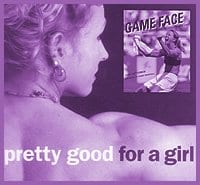Watching sports is one of the most socially accepted forms of voyeurism. There’s no shame or guilt in the pursuit of spectatorship; it’s encouraged in us from a tender age.
Of course, for some it’s the enactment of the classic question – do you want to be Amelie Mauresmo or do you want to have her?
The spectacle of sporting women is a relatively modern phenomenon, which can be used to trace the history of the women’s movement in the 20th century. Women athletes often symbolize the inroads women have made into bastions of male privilege. Women weren’t allowed to run in the Boston Marathon until 1972 – and while some would argue that running 26.2 miles is a crazy thing for anyone to aspire to, we’ve come to accept it shouldn’t be for guys only.
Dykes, at least those who have been steeped in the tomboy tradition, have been central to women’s part in athletics. (The lesbian softball phenomenon has been around long enough to be almost a cliché.) But it’s a role that few commentators on sporting women seem eager to acknowledge.
In Game Face: What Does A Female Athlete Look Like?, Jane Gottesman has put together a collection of photos of women engaging in a wide variety of athletic pursuits, ranging from the obvious to the sublime and then some. There’s ballroom dancing and bowling, baton twirling and cheerleading, marathon running and swimming, basketball and baseball, and the newest showcase for women’s athletic prowess, soccer. And let’s not forget the classic women’s stronghold of field hockey, which as I recall was one of the few things that the guys didn’t play.
Game Face looks exclusively at US women athletes, some known, but more unknown. Most of the subjects are contemporary, but there’s enough archival material to allow the book to qualify as serious. But there’s something missing.
Aside from a passing mention from a basketball player who was occasionally told, “You look like a dyke,” there’s no mention of either the stigma or the reality of lesbianism in the realm of female athletics. Yet an important aspect of the appeal of sports is the implicit (and sometimes explicit) sexual element that’s present. All that sweat, all those muscles, the concentration and the sheer energy of it can be pretty sexually intoxicating. Which is, after all, why everyone believes that all female jocks are dykes in the first place – all that sexual energy has to be going somewhere and there aren’t usually too many guys in the locker room or on the team bus.
But this book, like others of its kind, doesn’t get close to the issue of any flavour of sexuality in the arena.
If Game Face is a sanitized recruiting tool for bringing girls into the playing field, Leslie Heywood’s memoir Pretty Good For A Girl is a cautionary tale. Heywood started running competitively in high school in Arizona and her story is a textbook portrayal of both the tremendous highs and lows that are associated with competitive sports. Heywood captures the exhilaration she experienced through running and vividly depicts the pleasure she took from her relationship with her body.
Like some great sports novels (Jenifer Levin’s Water Dancer or The Sea Of Light, for instance), Heywood gets at the struggles and the rewards of competitive sports. She fully describes the feeling of living completely in one’s body and acknowledges what’s good and bad about that state. Being body conscious can be obsessive and destructive but, damn it, there’s nothing like that endorphin high.
Heywood does all this without creating an identity based on victimization, though there’s more than enough room for her to do just that. The book could have easily been subtitled, But Never Good Enough. Looking at all the pressure placed on her, one wonders about the high incidence of eating disorders and over-training among adolescent girls.
Heywood makes clear the rather sad truth of competitive sport: You’re only as good as your last race. Or, even more brutal: Once you stop winning, nobody remembers your name. When Heywood’s college track career ended because of a joint disorder, her solution is to become an aerobics instructor in order to finance her education. She is now a professor of English and a competitive bodybuilder. It’s as if she’s hardwired for competition and she doesn’t try to call it anything else.
Women and girls continue to be second-class citizens in the sport arena. It’s never merely about skill, talent or any of the other intangible aspects. It’s mainly about money and marketability. And that’s part of the reason why the lesbian contributions are forced to take a back seat.
Brandi Chastain’s famous victory image after the 1999 Women’s World Cup might well fuel the soccer aspirations – and sexual fantasies – of countless girls, but will it sell enough sports bras to pay for their training?

 Why you can trust Xtra
Why you can trust Xtra


